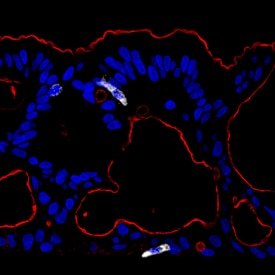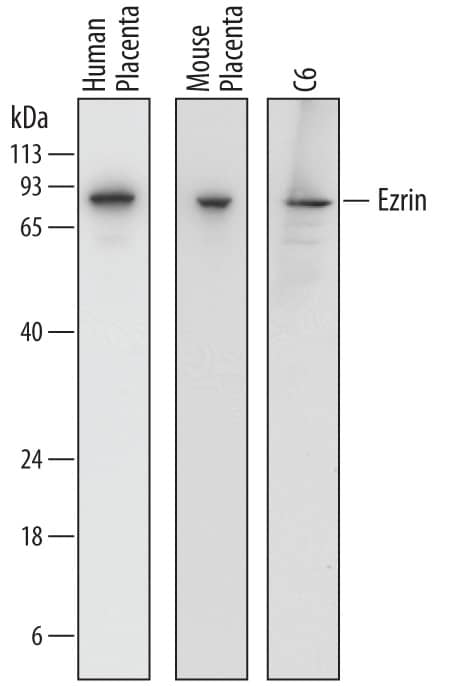Human/Mouse/Rat Ezrin Antibody
R&D Systems, part of Bio-Techne | Catalog # AF7239

Key Product Details
Species Reactivity
Validated:
Cited:
Applications
Validated:
Cited:
Label
Antibody Source
Product Specifications
Immunogen
Lys438-Arg562
Accession # P15311
Specificity
Clonality
Host
Isotype
Scientific Data Images for Human/Mouse/Rat Ezrin Antibody
Detection of Human, Mouse, and Rat Ezrin by Western Blot.
Western blot shows lysates of human placenta tissue, mouse placenta tissue, and C6 rat glioma cell line. PVDF membrane was probed with 0.2 µg/mL of Sheep Anti-Human/Mouse/Rat Ezrin Antigen Affinity-purified Polyclonal Antibody (Catalog # AF7239) followed by HRP-conjugated Anti-Sheep IgG Secondary Antibody (HAF016). A specific band was detected for Ezrin at approximately 81 kDa (as indicated). This experiment was conducted under reducing conditions and using Immunoblot Buffer Group 1.Detection of Human Ezrin by Simple WesternTM.
Simple Western shows lysates of Exosome Standard (HEK293) (NBP3-11684), Exosome Standard (PC-3) (NBP2-49856), and human cerebellum tissue, loaded at 0.5 mg/ml. A specific band was detected for Ezrin at approximately 76 kDa (as indicated) using 10 µg/mL of Sheep Anti-Human/Mouse/Rat Ezrin Antigen Affinity-purified Polyclonal Antibody (Catalog # AF7239). This experiment was conducted under reducing conditions and using the 12-230kDa separation system.Ezrin in Human Colon Stem Cells.
Ezrin was detected in immersion fixed paraffin-embedded sections of human colon stem cells differentiating into ascending colon using Sheep Anti-Human/Mouse/Rat Ezrin Antigen Affinity-purified Polyclonal Antibody (AF7239) at 0.5 µg/mL overnight at 4 °C. Tissue was stained using the NorthernLights™ 557-conjugated Anti-Sheep IgG Secondary Antibody (red; NL010). Chromogranin A was also detected using Mouse Anti-Human Chromogranin A Monoclonal Antibody (MAB90981) at 0.5 µg/mL overnight at 4 °C. Tissue was co-stained using the NorthernLights™ 637-conjugated Anti-Mouse IgG Secondary Antibody (red; NL008) and counterstained with DAPI (blue). Specific staining of Ezrin was localized to microtubules. View our protocol for Fluorescent IHC Staining of Frozen Tissue Sections.Applications for Human/Mouse/Rat Ezrin Antibody
Immunohistochemistry
Sample: Immersion fixed paraffin-embedded sections of human colon (colon stem cells differentiating into ascending colon) and human stomach
Simple Western
Sample: Exosome Standard (HEK293) (Catalog # NBP3-11684), Exosome Standard (PC-3) (Catalog # NBP2-49856), and human cerebellum tissue
Western Blot
Sample: Human placenta tissue, mouse placenta tissue, and C6 rat glioma cell line
Formulation, Preparation, and Storage
Purification
Reconstitution
Formulation
*Small pack size (-SP) is supplied either lyophilized or as a 0.2 µm filtered solution in PBS.
Shipping
Stability & Storage
- 12 months from date of receipt, -20 to -70 °C as supplied.
- 1 month, 2 to 8 °C under sterile conditions after reconstitution.
- 6 months, -20 to -70 °C under sterile conditions after reconstitution.
Background: Ezrin
EZRIN (also Cytovillin, Villin2 and p81) is a founding member of the ERM family, Band 4.1 Superfamily of proteins. Although its predicted MW is 69 kDa, it runs anomalously at 77-82 kDa in SDS-PAGE. ERZIN is expressed by epithelial cells where it serves as a linker between the cell membrane and the actin cytoskeleton. Its presence is particularly strong in microvilli where it helps organize this structure. In addition, ERZIN also organizes microtubules in lymphocytes at or near the immunological synapse by interacting with Glg1. Human EZRIN is 585 amino acids (aa) in length. It contains a band 4.1 homology/FERM domain that binds CD44, ICAM-1, EBP50 and ERM family members (aa 1-295), a central alpha-helical region (aa 296-352), and a C-terminal ERM and actin-binding/FERM C domain (aa 353-586). EZRIN exists as either a monomer, or a homo/heterodimer. EZRIN is not constitutively active, but must be phosphorylated and unfolded to bind to cytoplasmic proteins. Over aa 438-562, human EZRIN shares 96% aa identity with mouse EZRIN.
Alternate Names
Gene Symbol
UniProt
Additional Ezrin Products
Product Documents for Human/Mouse/Rat Ezrin Antibody
Product Specific Notices for Human/Mouse/Rat Ezrin Antibody
For research use only



